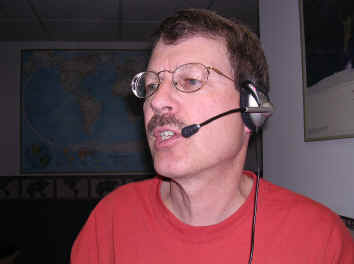
The Handiham Remote Base station beta testing is continuing at a good pace, and we are certainly getting educated on why it is necessary to have a testing period before going "live" as a member service!
Let's bring you up to date.
We started out in late August with the installation, taking advantage of the already-scheduled Handiham Radio Camp, when Lyle, K0LR, and I would already be at the station location Courage North. The radio, computer, and all associated equipment were funded by a generous gift from Kerry Flavours (thanks to K2OMQ for his help), and we were able to coordinate the purchase and delivery of the equipment in such a way that Lyle, K0LR, could pre-install some of the necessary software and get things working as much as possible before the trip to Courage North. Since the station would be a considerable distance from a metropolitan area, we had to made sure that we had planned for as many contingencies as possible. There isn't a Radio Shack store just down the block when you are far into the north, in Minnesota's woods and lake country! On the other hand, the location chosen for the station has the necessities that will make it work for us:
1. It is in a very quiet location, far from overhead power lines. All power lines in the area are underground. All wiring at the camp itself is underground.
2. Courage North has a T-1 Internet line, capable of high bandwidth use.
3. Courage North is the site of our Handiham Radio Camp, which allows us to use the station as a teaching tool. Since its location at camp is pretty far from the other antennas, the remote base can operate with less interference to and from the other stations at camp.
4. Tom, KB0FWQ, lives at Courage North year-round.
5. Bill, N0CIC, who helped us with the station installation, lives close by.
6. We have an excellent location for the station in the attic of the camp's dining hall, which will ultimately be the location for the entire T-1 line interface.
Since everything seemed to be coming together nicely, Lyle proceeded to introduce the radio campers to the new radio and the computer interface prior to the actual installation in the dining hall. Later on in the week, we recruited Handiham volunteer Bill, N0CIC, to help us with the installation of the G5RV antenna. The computer was set up along with the radio, rig interface, LDG tuner, and feedline with a gas-discharge lightning arrestor. Lyle had to configure the system to be able to "handshake" with the Internet system, with all that entails. Thankfully we have a static IP address with the T-1 line. And even more thankfully, Lyle understands how to make this stuff work. Our volunteers are quite simply the best!
Following Radio Camp, we entered the beta test phase. Lyle and I are able to access the station computer by remote control, making it possible to configure the software and add users, administrate computer updates, and so forth. We began with the assumption that the Kenwood rig control software would most likely serve our needs. We had tested the user interface software by Kenwood, which is called ARCP-480. It seemed to be very accessible to screen reader users and the interface was easy to understand. On the remote base control computer the Kenwood program called ARHP-10 had to be running so that users could log on.
So far, so good. We proceeded to recruit and add beta testers, and we were getting some good feedback about the station from them. Then something unexpected happened. We had 10 users and could not add an eleventh user. It turned out that the Kenwood control software running on the remote base computer would only accept a maximum of 10 users, something that did not appear to be documented anywhere in the help file. An e-mail exchange with Kenwood confirmed the limitation. Clearly, this software would not serve as our final installation, because we could not confine the user base to only 10!
Fortunately, Stan, W4MQ, has written some excellent rig control software for remote base use. Even better, Stan's software can be configured for users with different privileges based on license class. This can help us administrate the station to stay within FCC rules, as well as helping users to stay within their license class privileges. We had to make the shift to the W4MQ software, which we did last week. Beta testers were informed of the change, and this week we have posted some new instructions on the handiham members only website under the remote base link.
We will be refining these pages as time goes on, but handiham members are encouraged to go ahead and take a look at the remote base pages and download the software so that they will be ready when we get out of beta test phase. In the meantime, if you want to take a look at Google Earth and see exactly where the station is located, go to our website for a link to the Google Earth location.
You must have Google Earth installed on your computer for this file to work.
I know this whole business of a remote base controlled by the Internet sounds complicated and confusing to some of you, but we are working hard to get the bugs out of the system and make it more user-friendly. I hope that by early 2009 we will be able to have the station available in several different ways for members to enjoy. Thanks to our donors, who support the work that we do, our volunteers whose patience and dedication to helping handiham members get on the air to make the program work, and to our members who continue to amaze me with their kindness and willingness to help us in every way possible.
Patrick Tice, WA0TDA
Handiham Manager



